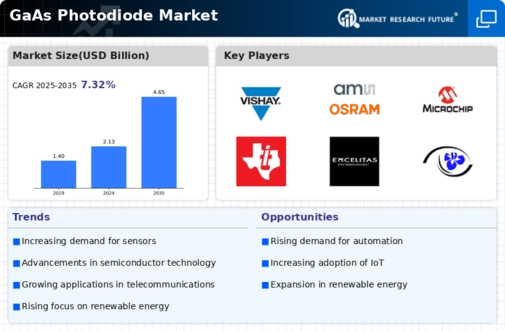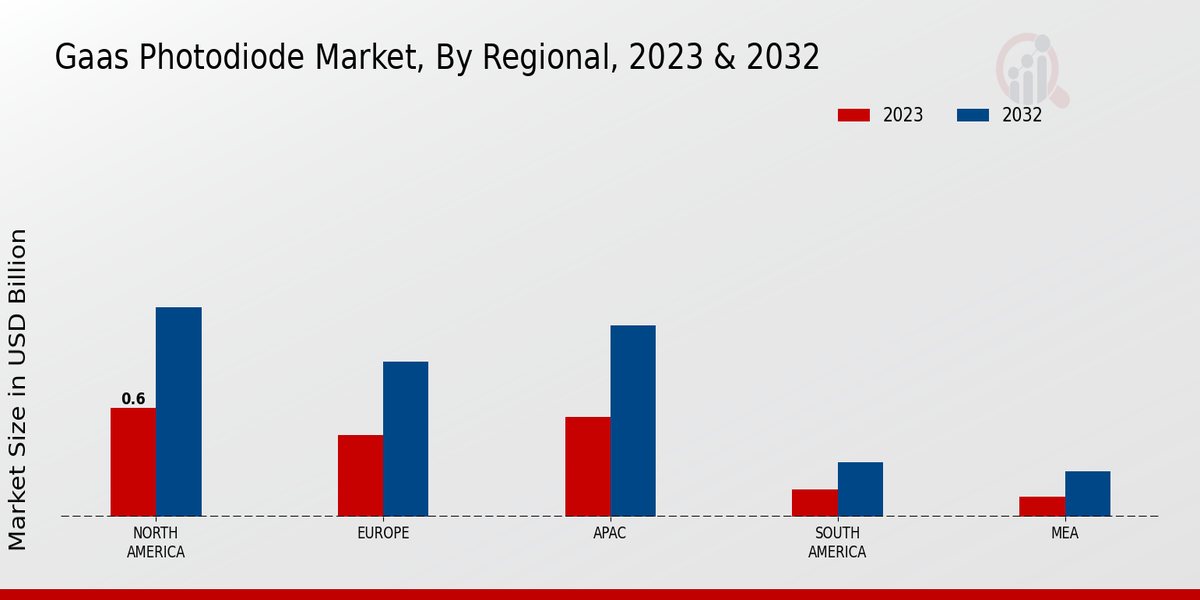Market Growth Projections
The Global GaAs Photodiode Market Industry is projected to experience substantial growth over the coming years. With a market value of 2.13 USD Billion in 2024, it is expected to reach 4.65 USD Billion by 2035. This growth trajectory indicates a compound annual growth rate (CAGR) of 7.35% from 2025 to 2035. The increasing adoption of GaAs photodiodes across various sectors, including telecommunications, consumer electronics, and industrial applications, contributes to this positive outlook. The market's expansion reflects the ongoing technological advancements and the rising demand for efficient photodetectors in diverse applications.
Advancements in Consumer Electronics
The Global GaAs Photodiode Market Industry is significantly influenced by advancements in consumer electronics. With the proliferation of devices such as smartphones, tablets, and smart home technologies, the demand for efficient photodetectors is on the rise. GaAs photodiodes offer superior performance in terms of sensitivity and response time, making them ideal for applications in cameras and sensors. As consumer electronics manufacturers increasingly adopt these components, the market is poised for growth. Projections indicate that by 2035, the market could expand to 4.65 USD Billion, driven by continuous innovation and consumer demand for high-quality electronic devices.
Growing Demand in Telecommunications
The Global GaAs Photodiode Market Industry experiences a surge in demand driven by the telecommunications sector. As 5G networks expand, the need for high-speed data transmission increases, necessitating advanced photodetectors. GaAs photodiodes, known for their efficiency and speed, are integral to optical communication systems. In 2024, the market is projected to reach 2.13 USD Billion, reflecting the industry's adaptation to evolving communication technologies. This growth is indicative of the broader trend towards enhanced connectivity, which is expected to continue fueling demand for GaAs photodiodes in telecommunications applications.
Emerging Applications in Medical Devices
The Global GaAs Photodiode Market Industry is witnessing emerging applications in the medical device sector. GaAs photodiodes are increasingly used in diagnostic equipment, imaging systems, and therapeutic devices due to their high sensitivity and rapid response times. The integration of these photodetectors enhances the accuracy and reliability of medical instruments, which is crucial for patient care. As healthcare technology advances, the demand for innovative solutions is expected to grow. This trend indicates a potential for significant market expansion, as the medical sector continues to invest in advanced technologies that incorporate GaAs photodiodes.
Environmental Monitoring and Safety Systems
The Global GaAs Photodiode Market Industry is also driven by the growing need for environmental monitoring and safety systems. GaAs photodiodes are employed in various applications, including air quality monitoring, radiation detection, and safety systems in hazardous environments. Their ability to provide accurate and real-time data is essential for regulatory compliance and public safety. As governments and organizations prioritize environmental protection and safety, the demand for reliable photodetectors is likely to increase. This trend underscores the versatility of GaAs photodiodes and their critical role in addressing contemporary environmental challenges.
Increased Adoption in Industrial Applications
The Global GaAs Photodiode Market Industry sees increased adoption in various industrial applications, particularly in automation and robotics. GaAs photodiodes are utilized in sensors and imaging systems, enhancing operational efficiency and precision. Industries such as manufacturing and logistics are integrating these photodetectors into their systems to improve productivity and reduce errors. The anticipated compound annual growth rate (CAGR) of 7.35% from 2025 to 2035 suggests a robust expansion in this sector. As industries continue to embrace automation, the demand for reliable and efficient photodiodes is likely to rise, further propelling market growth.













